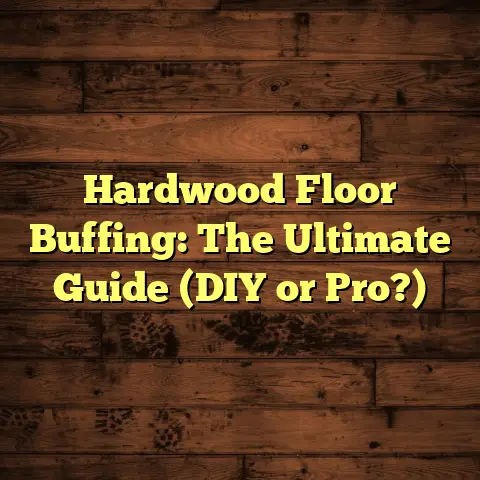Hardwood Without Subfloor: Fix? (2 Methods!)
Flooring is the foundation of any room, literally and figuratively, right?
It impacts the look, feel, and even the acoustics of your space.
And let’s be honest, nothing beats the timeless beauty and durability of hardwood.
But what happens when you’re faced with a challenging situation like, say, no subfloor?
I’ve seen the panic in homeowners’ eyes when they realize this.
“Can I even install hardwood?” “Is it going to be a disaster?”
The answer is a resounding yes, you can!
But it requires the right knowledge, preparation, and methods.
That’s why I’m here to share my expertise and guide you through the process.
We’ll explore two effective methods for installing hardwood without a subfloor, giving you the confidence to tackle this project head-on.
Let’s dive in!
Section 1: Expert Picks for Hardwood Flooring Installation
1.1 Overview of Expert Recommendations
Over the years, I’ve noticed a growing interest in installing hardwood directly onto concrete slabs or even over existing flooring.
Why?
Because it can save time, money, and a whole lot of hassle.
But it’s crucial to approach this with caution and the right materials.
I’ve consulted with other flooring pros, read countless industry reports, and tested various products myself to find the best solutions.
The key takeaway?
Not all hardwood is created equal when it comes to subfloor-less installation.
You need to consider factors like moisture resistance, stability, and the specific conditions of your space.
1.2 Selection Criteria
When recommending hardwood for installation without a subfloor, I look for these key criteria:
- Moisture Resistance: This is huge, especially with concrete slabs.
You need a product that can handle potential moisture vapor transmission. - Dimensional Stability: The wood shouldn’t expand or contract excessively with changes in humidity.
Warping and gapping are no-nos! - Thickness: Thicker planks often provide better stability and a more solid feel underfoot.
- Installation Method: Some hardwoods are specifically designed for floating or glue-down installation, making them ideal for these scenarios.
- Warranty: A good warranty indicates the manufacturer’s confidence in their product’s performance.
1.3 Top Expert Picks
Based on these criteria, here are my top picks for hardwood flooring when you’re skipping the subfloor:
Pick #1: Engineered Hardwood
Engineered hardwood is my go-to recommendation for a reason.
It’s constructed with multiple layers of wood veneer bonded together, making it significantly more stable than solid hardwood.
Why I love it:
- Superior Moisture Resistance: The core layers are often made from plywood or high-density fiberboard (HDF), which are more resistant to moisture than solid wood.
- Dimensional Stability: The cross-layered construction prevents warping and cupping.
- Versatile Installation: It can be installed using a variety of methods, including floating, glue-down, or nail-down (depending on the specific product).
Specific Recommendations:
- [Brand Name] Engineered Hardwood (e.g., Shaw Repel Water Resistant Hardwood): I’ve had great success with [Brand Name]’s engineered hardwood lines.
Their Repel series, for example, boasts enhanced water resistance, making it perfect for basements or areas prone to spills.
They offer various wood species, colors, and plank sizes. - [Brand Name] Engineered Hardwood (e.g., Armstrong Performance Plus): Another solid choice is [Brand Name].
Their Performance Plus line is known for its durability and scratch resistance, which is great for high-traffic areas.
Drawbacks:
- Cost: Engineered hardwood can be more expensive than laminate flooring, but it’s generally more affordable than solid hardwood.
- Refinishing Limitations: Depending on the thickness of the top veneer, you may only be able to refinish it once or twice.
Pick #2: Floating Hardwood Floors
Floating hardwood floors are a game-changer because they don’t require nails or glue to be attached to the subfloor.
Instead, the planks interlock together, creating a “floating” surface.
This is particularly useful when dealing with uneven concrete or existing flooring where you don’t want to cause damage.
Why I love it:
- Easy Installation: Floating floors are incredibly DIY-friendly.
The click-lock system makes installation quick and straightforward. - Versatility: They can be installed over various surfaces, including concrete, tile, and vinyl.
- Comfort: Many floating floors come with an attached underlayment, providing extra cushioning and sound absorption.
Specific Recommendations:
- [Brand Name] Floating Hardwood (e.g., Cali Bamboo Fossilized Bamboo Flooring): While technically bamboo, Cali Bamboo’s Fossilized Bamboo is harder than most hardwoods and extremely durable.
Their click-lock system is easy to use, and the planks are incredibly stable.
Plus, bamboo is a sustainable and eco-friendly option. - [Brand Name] Floating Hardwood (e.g., Vesdura Vinyl Planks): While technically not hardwood, Vesdura offers incredible wood-look vinyl planks that are waterproof and incredibly durable.
They’re a great option for bathrooms or kitchens where moisture is a concern.
Drawbacks:
- Hollow Sound: Floating floors can sometimes sound hollow when walked on, especially if the subfloor is uneven.
Using a high-quality underlayment can help mitigate this. - Potential for Movement: If not installed properly, floating floors can shift or separate over time.
Following the manufacturer’s instructions carefully is crucial.
Section 2: Method 1 – Installing Hardwood on a Concrete Slab
2.1 Understanding Concrete Slabs
Concrete slabs are a common foundation in many homes, especially in basements or ground-level floors.
They’re durable and relatively inexpensive, but they also present some challenges when it comes to hardwood installation.
The biggest concern is moisture.
Concrete is porous and can absorb moisture from the ground, which can then transfer to your hardwood flooring, causing warping, cupping, and mold growth.
That’s why proper preparation is absolutely essential.
2.2 Preparation Steps
Before you even think about laying down a single plank, you need to prep that concrete slab like your flooring’s life depends on it (because it kinda does!).
Here’s what I recommend:
- Cleaning: Thoroughly clean the concrete slab to remove any dirt, dust, grease, or adhesive residue.
I like to use a concrete cleaner and a stiff brush, followed by a good rinse.
Let it dry completely. - Moisture Testing: This is non-negotiable.
You need to determine the moisture content of the concrete slab before proceeding.
I use a concrete moisture meter to get an accurate reading.
According to the National Wood Flooring Association (NWFA), the moisture content of the concrete should be within a certain range, typically below 4.5% for wood flooring installation. - Vapor Barrier: If the moisture test reveals high levels of moisture, you’ll need to install a vapor barrier to prevent moisture from migrating into the hardwood.
I recommend a high-quality polyethylene film that is at least 6 mil thick.
Overlap the seams by at least 6 inches and tape them securely. - Leveling (If Necessary): If the concrete slab is uneven, you’ll need to level it out before installing the hardwood.
Use a self-leveling concrete compound to fill in any low spots or cracks.
Follow the manufacturer’s instructions carefully.
2.3 Installation Process
Alright, now for the fun part!
Here’s a step-by-step guide to installing hardwood flooring on a concrete slab:
Step-by-Step Guide
- Acclimate the Hardwood: Allow the hardwood flooring to acclimate to the room’s temperature and humidity for at least 72 hours before installation.
This will help prevent expansion and contraction after installation.
Stack the boxes of flooring in the room where they will be installed. - Install Underlayment (If Necessary): Some engineered hardwood floors come with an attached underlayment.
If not, you’ll need to install a separate underlayment to provide cushioning, sound absorption, and moisture protection.
Roll out the underlayment according to the manufacturer’s instructions. - Start Installing the First Row: Begin installing the first row of hardwood planks along a straight wall, leaving a 1/4-inch expansion gap between the wall and the flooring.
Use shims to maintain the expansion gap. - Click-Lock or Glue Down: Depending on the type of hardwood flooring, you’ll either click the planks together or glue them down to the concrete slab.
For click-lock floors, simply align the tongue and groove edges and snap them together.
For glue-down floors, apply adhesive to the concrete slab using a trowel, and then carefully position the planks. - Continue Installing Subsequent Rows: Continue installing subsequent rows of hardwood planks, staggering the end joints to create a more visually appealing and structurally sound floor.
Use a tapping block and a mallet to ensure a tight fit between the planks. - Cut Planks as Needed: Use a saw to cut planks to fit around doorways, corners, and other obstacles.
Be sure to measure accurately before cutting. - Install Baseboards and Trim: Once the flooring is installed, remove the shims and install baseboards and trim to cover the expansion gap and give the floor a finished look.
Tips from Experts
- Use the Right Adhesive: If you’re gluing down the hardwood, use an adhesive that is specifically designed for hardwood flooring and concrete slabs.
I recommend [Adhesive Brand] adhesive. - Work in Small Sections: When gluing down the hardwood, work in small sections to prevent the adhesive from drying out before you can position the planks.
- Check for Level Regularly: Use a level to check the floor’s surface regularly during installation.
If you find any uneven spots, use shims to level them out.
2.4 Common Mistakes to Avoid
- Skipping the Moisture Test: This is the biggest mistake I see DIYers make.
Ignoring moisture issues can lead to serious problems down the road. - Not Acclimating the Hardwood: Allowing the hardwood to acclimate to the room’s environment is crucial for preventing expansion and contraction.
- Using the Wrong Adhesive: Using the wrong adhesive can result in a weak bond and flooring failure.
- Not Leaving an Expansion Gap: Failing to leave an expansion gap can cause the flooring to buckle or warp when it expands.
- Rushing the Installation: Take your time and pay attention to detail.
Rushing the installation can lead to mistakes that will be costly to fix.
Section 3: Method 2 – Installing Hardwood Over Existing Flooring
3.1 Assessing the Existing Flooring
Sometimes, tearing up the old flooring seems like too much work.
Good news!
You can often install hardwood over existing flooring, but only if it’s the right candidate.
Here’s what you need to consider:
- Stability: The existing floor needs to be structurally sound and stable.
If it’s loose, damaged, or uneven, it’s not a good candidate. - Levelness: The existing floor needs to be relatively level.
Minor imperfections can be addressed with self-leveling compound, but significant unevenness will need to be corrected before installing the hardwood. - Type of Flooring: Certain types of flooring are better suited for hardwood installation than others.
For example, solid, well-adhered tile or sheet vinyl are generally good candidates, while carpet or loose-lay vinyl are not. - Height Considerations: Installing hardwood over existing flooring will raise the floor height.
Make sure this won’t create any issues with doorways, transitions, or appliances.
3.2 Preparation Steps
Okay, so you’ve determined that your existing floor is a suitable base.
Now it’s time to prep!
- Cleaning: Thoroughly clean the existing flooring to remove any dirt, dust, grease, or wax.
Use a cleaner that is appropriate for the type of flooring you’re cleaning. - Leveling: If there are any minor imperfections in the existing flooring, use a self-leveling compound to fill them in.
Follow the manufacturer’s instructions carefully. - Addressing Structural Concerns: If there are any loose or damaged areas in the existing flooring, repair them before installing the hardwood.
For example, you may need to re-glue loose tiles or replace damaged sections of vinyl. - Underlayment (Optional): Depending on the type of existing flooring and the type of hardwood you’re installing, you may want to install an underlayment to provide cushioning, sound absorption, and moisture protection.
3.3 Installation Process
The installation process for installing hardwood over existing flooring is similar to installing it on a concrete slab, with a few key differences:
Step-by-Step Guide
- Acclimate the Hardwood: Allow the hardwood flooring to acclimate to the room’s temperature and humidity for at least 72 hours before installation.
- Install Underlayment (If Necessary): Roll out the underlayment according to the manufacturer’s instructions.
- Start Installing the First Row: Begin installing the first row of hardwood planks along a straight wall, leaving a 1/4-inch expansion gap between the wall and the flooring.
Use shims to maintain the expansion gap. - Click-Lock or Glue Down: Depending on the type of hardwood flooring, you’ll either click the planks together or glue them down to the existing flooring.
For click-lock floors, simply align the tongue and groove edges and snap them together.
For glue-down floors, apply adhesive to the existing flooring using a trowel, and then carefully position the planks. - Continue Installing Subsequent Rows: Continue installing subsequent rows of hardwood planks, staggering the end joints to create a more visually appealing and structurally sound floor.
Use a tapping block and a mallet to ensure a tight fit between the planks. - Cut Planks as Needed: Use a saw to cut planks to fit around doorways, corners, and other obstacles.
Be sure to measure accurately before cutting. - Install Baseboards and Trim: Once the flooring is installed, remove the shims and install baseboards and trim to cover the expansion gap and give the floor a finished look.
Expert Insights
- Choose the Right Hardwood: Engineered hardwood or floating hardwood are the best choices for installing over existing flooring because they’re more stable and less likely to be affected by moisture.
- Consider Transition Strips: You’ll likely need to install transition strips where the new hardwood floor meets existing flooring in other rooms.
Choose transition strips that match the hardwood flooring and provide a smooth transition between the two surfaces. - Be Mindful of Door Clearances: Installing hardwood over existing flooring will raise the floor height, so be sure to check that doors will still swing freely.
You may need to trim the bottom of doors to provide adequate clearance.
3.4 Troubleshooting Issues
- Squeaky Floors: If the existing floor is squeaky, try to identify the source of the squeak and repair it before installing the hardwood.
You may need to screw down loose subfloor boards or apply shims to eliminate movement. - Uneven Surfaces: If the existing floor is significantly uneven, you may need to install a layer of plywood or cement board to create a level surface before installing the hardwood.
- Moisture Problems: If the existing floor is prone to moisture problems, be sure to address them before installing the hardwood.
You may need to install a vapor barrier or improve ventilation in the room.
Conclusion
So, there you have it!
Two proven methods for tackling hardwood installation without a subfloor.
Whether you’re working with a concrete slab or covering existing flooring, the key is to choose the right materials, prepare meticulously, and follow the installation steps carefully.
Remember those expert picks?
Engineered hardwood and floating hardwood floors are your best friends in these scenarios, offering stability, moisture resistance, and ease of installation.
While it might seem daunting at first, installing hardwood without a subfloor is absolutely achievable with the right knowledge and a bit of elbow grease.
Don’t be afraid to tackle this project yourself, but always remember to consult with a professional if you’re unsure about any aspect of the process.
Happy flooring! And may your home be forever stylish and solid underfoot.





